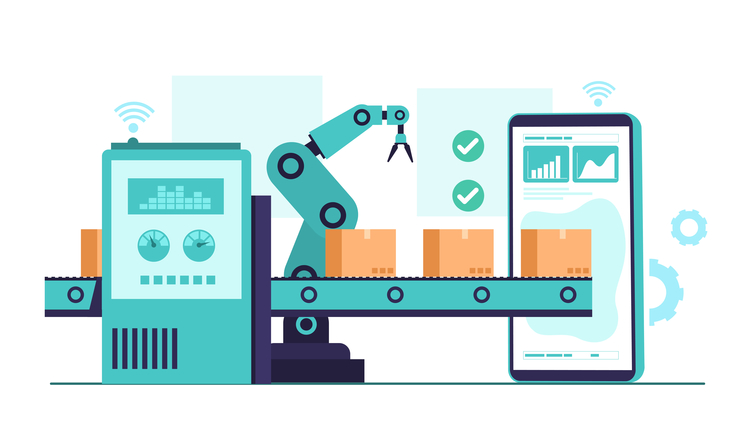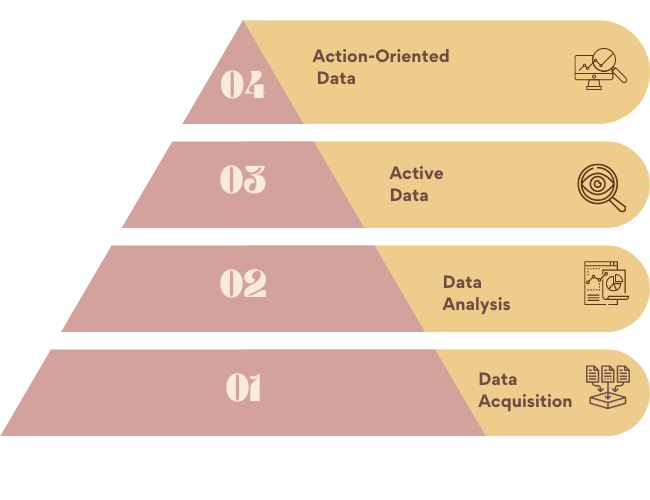What are the benefits of e-transforming your usual factory to a smart factory? – if that is your question, this article will give you a comprehensive overview covering the what-why-hows and more !
Steam engines, assembly lines & computers
What do they have in common?
Well, they are the products of the first three industrial revolutions which shaped the global markets and altered how we lived as a society, worked, and interacted with one another. And, as we stand on the verge of the fourth industrial revolution, cutting-edge technologies such as Artificial Intelligence, Machine learning for Robotics, 5G, and so on will bring in a new and transformed wave of automation that will lay the groundwork for smart factories. Thus, will make it one of the most transformative periods in manufacturing since the invention of the steam engine. Furthermore, in today's society, where digital transformation is not just a top priority but also a requirement for business success, you need to be ready to take advantage of smart factories to enhance your business’s bottom line & productivity.
And, to assist you in making the transition from "traditional factory" to "smart factory," this article can be just what you need.
So without further ado, let’s take a closer look at the nitty-gritties of the smart factory and how it is revolutionizing the manufacturing industry and transforming its operations for a better future.
Get Complimentary Smart Factory Software Consultation!
Source : Foturne Business Insights
What Is A Smart Factory?
Quite as the name suggests – ‘smart’ refers to internet involvement and ‘factory’ refers to manufacturing activities.
Together, smart factory is a concept of using advanced Industry 4.0 technologies such as cloud computing, Big Data, Digital Twins etc. to create a highly connected manufacturing facility. These technologies operate by collecting and sharing data on machines and manufacturing systems in real time via interconnected devices. This data can then be used to monitor and analyze various operational processes in order to optimize the entire production environment, resulting in higher profitability for your business.
Smart Factory – What Technologies Are Used In It ?
Before jumping into the fundamentals of a smart factory– let’s first understand what all technologies are used in it & how they shape smart manufacturing.
These technologies include :
[1] Industrial IoT
IIoT, or Industrial IoT, is a subcategory of IoT that focuses on the use of various digital tools, such as smart sensors and actuators, for data collection. The data that is collected is further forwarded to the cloud servers for processing and analyzing. Once data analysis is done, IIoT provides actionable insights on various manufacturing processes, which can then be used to improve the production environment, ensuring increased operational efficiency.
Also read : IoT In Manufacturing – Worth or Not !
[2] Cloud Computing
Cloud computing, via data centers, stores massive amounts of real-time data collected from IoT sensors that are attached to various manufacturing machines & devices. These collected data can be accessed by its users via an internet connection and can be shared with the relevant people at the right time, seamlessly. Not only that, but cloud computing in smart factories also helps in processing those data and provides valuable information on manufacturing processes that can be used to optimize various production operations. Furthermore, it also keeps multiple copies of data as backup to address issues such as data loss, breaches, or infringements, ensuring high data security.
Also read : What is Saas? A Complete Guide
[3] Machine Learning
Machine learning (ML) analyses failure patterns in machinery & devices using historical equipment maintenance data as well as live data and notifies users through alerts prior to system failure. Aside from that, ML in smart factories also schedules timely maintenance programmes to detect developing machinery defects and keeps users informed of its status by providing them condition monitoring reports. Thus, by reducing the probability of machinery defects, machine learning ensures higher product quality and improved asset reliability.
[4] Digital Twins
With the help of digital twins, you can create virtual copies of the products manufactured by your business and make changes to them for various experimental purposes or to test new designs. These changes can then assist you in identifying the product's capability as well as product issues before it goes into production. Additionally, modifications to digital twins can also reveal new approaches to improve production, boost the development of new products, and enhance product reliability.
[5] Big Data Analytics
Huge amounts of data are generated by your manufacturing processes on a daily basis, and as it accumulates over time, the chances of gaining more insights into operational processes, strengthen.
How?
Basically, using Big data which analyses and sorts through those accumulated data, as well as leverages organizational historical data, to make future predictions and identify impending risks & opportunities. Furthermore, it also uses Industry 4.0 technologies such as AI and machine learning to layer algorithms for identifying anomalies even in highly complex manufacturing processes and provides you with real-time solutions on the same, which can then be used for addressing issues.
[6] Blockchain
With the help of cybersecurity frameworks, decentralized data storage, and cryptography, blockchain provides high-level data confidentiality and security, making it extremely difficult for malicious parties to tamper with or delete data from your ledger. Aside from that, blockchain in smart factories can also be used for creating “smart contracts” across your supply chain, which can simply automate the regulation and execution of the terms & conditions listed in the contract without human supervision. Thus, saving time on repetitive tasks.
[7] Augmented Reality (AR)
By integrating AR technology into your workers smartphones & tablets, you can significantly reduce the time spent by your workers picking up a product from warehouses, as it can easily :
[i] Provide your workers with instructions about the exact location of a particular item by recognizing it through computer vision technology, which analyzes the video stream.
And,
[ii] Lead them to that very area where the item is located and the shelf where it is stored, with ultimate accuracy.
Also read : Warehouse Management System – This is how to choose the best!
[8] Virtual Reality (VR)
With VR technology you can have the chance to have a nearly flawless assembly.
Wonder, how?
Basically, using goggles that contain depth sensors, stereoscopic display, & head-motion-tracking sensors, you will be able to view your entire production process in real-time. Through VR goggles, you can even virtually touch your manufacturing items to check their quality as well as walk through your warehouses and factory assemblies to see how object parts are being assembled in real-time. This gives you the opportunity to pinpoint areas where you are falling short and where you can make a big difference, thereby improving operational effectiveness and making you move one step closer towards your smart factory.
[9] Additive Manufacturing
Additive manufacturing is the process by which an object is built by depositing material, layer by layer on geometrical shapes with the help of a CAD software. This can be used to create objects of almost any size & shape, and it is also easily customizable, allowing for the creation of differentiated products. Not only that, but you can also use additive manufacturing in smart factories to create legacy parts that are no longer available in the market through X-ray analysis of the original part and then release it to the market and reap monetary benefits from it.
What Are The Benefits Of A Smart Factory?
The fact that smart factories are the center of contemporary buzz isn't the only reason you should go for it. The first step in developing your "smart factory" should always be to analyze the benefits of developing a smart factory and then align it with your business's core goals.
So, to help you through the process, we've compiled a list of some of the advantages of a smart factory :
What Are The Four Levels Of A Smart Factory?
Ample data are generated from your production processes every day, and without proper management, it becomes extremely difficult to analyze them for future improvements. Thus, such mismanaged data hampers the efficient functioning of a manufacturing process .
But don't worry; to overcome this barrier and eliminate data management challenges, you’ll need to simply follow a four-stage journey that will pave the way for the transformation from legacy manufacturing to smart factories as well as provide long-term benefits.
So the four levels of a smart factory are :
Level 1 – Basic Data Acquisition
At this basic level of smart factories, data is available, but it is dispersed across systems that are disconnected from one another, making it difficult to analyze and use for decision making. Sorting through available data and converting it into insightful data requires a significant amount of manual labor, which can lead to inaccuracies. Not only that, but if machinery or quality issues arise at this stage, workers will have to dig into those manually collected data to determine the cause of the problem and find ways to repair it, which is again time-consuming. Thus, makes the entire production process expensive in terms of time & efforts as well as highly inefficient.
Level 2 – Data analysis
In the Level 2 of a smart factory, systems combine all scattered data and organize it in a single location with the assistance of additional systems. The organized data is easily accessible and allows workers to focus on high priority issues such as addressing system failure, product customization, product improvement, and so on. Although, identifying faults in production processes and scheduling production development & maintenance programs still involves manual labor.
Level 3 – Active Data
To get to this stage, you'll need to integrate smart factory technologies like AI and machine learning (ML) into your existing data architecture. With AI and machine learning, you'll be able to analyze data and generate useful insights with minimal human intervention. Not only that, but it also identifies high-performance areas and predicts future opportunities & issues before system failure occurs, which was not feasible at level 2. This enables your workforce to be more dynamic and aids them in preventing future production failures.
Level 4 – Action-Oriented Data
At this level, Industry 4.0 technologies such as AI and machine learning (ML) can identify optimizable areas and generate & send actionable plans to manufacturing devices to improve those areas as well as offer practical solutions to the problems identified in the previous stage. The manufacturing devices and machinery then carry out those changes mechanically, without the need for human intervention. Thus, ensuring the successful transition from traditional factory to smart factory.
Why Does Developing Your Smart Factory Software Solution With Binaryfolks Make For A Wise Choice?
Looking for a smart factory software development team that will provide exceptional service and enhance your entire manufacturing process?
BinaryFolks can undoubtedly help you with this. Our skilled and specialized software developers have firsthand experience in delivering a wide range of projects for clients from various industries. With BinaryFolks, you can easily unlock the full potential of your smart factory software and accelerate your company's growth graph.
So, here’s what to expect if developing your smart factory software with BinaryFolks :
Driven by ex-engineers from Google, Amazon & Salesforce
101% Value For Money (+1 for Our Complimentary Consultation before You Spend Your 1st Dollar!)
Reviews That You Can Verify!
Safeguarded Business With An NDA
Out-Of-The-Box Innovations
Eye For Details
Questions Galore (Until Your Requirement & Our Understanding are mirror copies!)
Insight-Rich Scope Enhancement
Intense Domain Expertise
Close-knit feedback loop
Conclusion
Now that you've gathered most of the information on smart factories, it's time to put your plan into action and develop a smart factory software solution that will improve your operational processes and overall business.
Not sure how to get started ?



.png)
.png)
.png)
.png)
.png)
